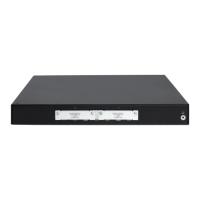302
Item Description
Mode
Set the STP operating mode:
• STP mode—All ports of the device send out STP BPDUs.
• RSTP mode—All ports of the device send out RSTP BPDUs. If the
device detects that it is connected to a legacy STP device, the port
connecting to the legacy STP device will automatically migrate to
STP-compatible mode.
• MSTP—All ports of the device send out MSTP BPDUs. If the device
detects that it is connected to a legacy STP device, the port connecting
to the legacy STP device will automatically migrate to STP-compatible
mode.
Max Hops
Set the maximum number of hops in an MST region to restrict the region
size.
The setting can take effect only when it is configured on the regional root
bridge.
Path Cost Standard
Specify the standard for path cost calculation. It can be Legacy, IEEE
802.1D-1998, or IEEE 802.1T.
Bridge Diameter
Any two stations in a switched network are interconnected through a specific
path composed of a series of devices. The bridge diameter (or the network
diameter) is the number of devices on the path composed of the most
devices.
After you set the network diameter, you cannot set the timers. Instead, the
device automatically calculates the forward delay, hello time, and max age.
When you configure the bridge diameter, follow these guidelines:
• The network diameter applies to only the CIST. It takes effect only after
you configure it on the root bridge. Each MST region is regarded as a
device.
• After you set the network diameter, you cannot set the timers. Instead,
the device calculates the forward delay, hello time, and max age
automatically.

